Hallmark RV announces the world’s first commercially available 100% composite truck camper. No wood. No aluminum. Just lots of Coosa, Coosa, and more Coosa.

A decade from now we may all look back at Hallmark’s new Coosa truck camper as the dawn of a new era in truck camper design. We have had many companies incorporate composite materials such as Azdel into their campers, and one company has stripped wood completely out of their units in favor of aluminum, but never have we had a manufacturer build and offer a 100% composite Hallmark truck camper.
Composites potentially offer the best of the aluminum and wood worlds; the strength and water proof qualities of aluminum, and the insulating warmth and flexibility of wood. No more aluminum sweat. No more worries of wood rot.
In reality, nothing is that simple. While exciting new composite materials are available, most of them are prohibitively expensive. New composites also require a camper manufacturer to invest heavily in new construction techniques that disrupt their production lines, not to mention their bottom lines. After all, the truck camper industry is just that, an industry. As alluring as new composite materials may be, they must make business sense. Composite campers must sell and be profitable.
Enter Hallmark with their new Coosa option. While Coosa certainly fits the expensive and development intensive description above, Hallmark has found a way to bring this exciting new material into our industry and make a true 100% composite camper not only possible, but available. Is it perfect? Of course not, but it’s the kind of important breakthrough that we need to take truck camper design forward.
For anyone who has long wondered why the industry doesn’t build a truck camper with modern composites, mark your calendars. The future is now.
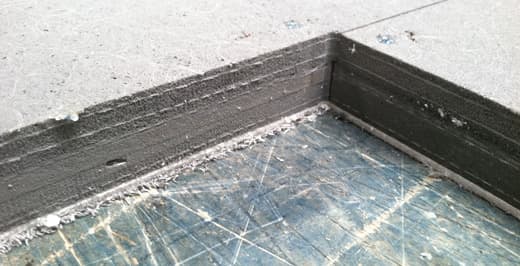
Above: A Hallmark Coosa floor before it had the linoleum installed
The following is an interview with Matt Ward of Hallmark RV on the new Hallmark RV Coosa option.
TCM: What is Coosa?
Matt: Coosa is a high density polyurethane foam reinforced with layers of stranded fiberglass to become a strong and structural building material. Coosa is designed to replace wood. You can screw and staple into Coosa just like wood, but you can’t use wood glues. Only urethane adhesives work with Coosa.
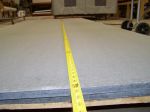 |
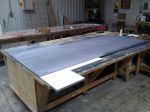 |
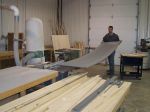 |
Above: Andy Ward working with the Coosa paneling at Hallmark RV
TCM: Why are you using Coosa to build Hallmark truck campers?
Matt: A few years ago we started looking at the new composite materials like Coosa and Azdel. Some of our customers have reservations about wood, so we started experimenting with these new composites. Coosa turned out to be an excellent wood or aluminum replacement for our truck campers.
Coosa is lighter than even a hollow aluminum tube, but, in all honesty, we didn’t save as much weight as we were hoping to save. We just completed a 100% Coosa Hallmark Milner. This camper has no wood or aluminum, period. When we weighed the 100% Coosa Milner, it was only about fifty pounds lighter than a standard Milner.
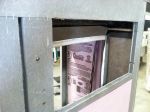 |
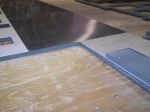 |
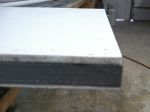 |
Left to Right: Refrigerator cabinet, wall on the kitchen side with the backing on top of Coosa, the layers of the wall
TCM: You’re making some additional news here. Are you stating that Hallmark will now offer aluminum frames along with wood and Coosa?
Matt: Yes. Our customers can now order a Hallmark truck camper with wood framing, aluminum framing, or Coosa framing.
TCM: What led Hallmark to offer aluminum framed campers?
Matt: Some customers want aluminum framing. After many years of customer requests, we have decided to offer that option. As a company, we still strongly prefer wood framing, but we are now offering aluminum framed Hallmark truck campers. We have an experienced aluminum welder on the team and look forward to building the best aluminum framed pop-up truck campers available. To anyone who ever wished for an aluminum framed Hallmark, we’re ready to go.
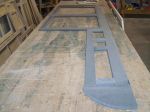 |
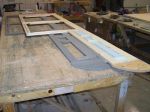 |
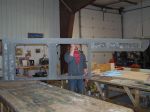 |
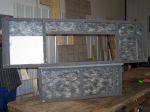 |
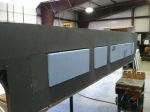 |
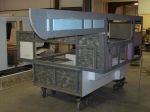 |
Above: The Coosa Hallmark frame being built
TCM: We’re going to have to follow up on your aluminum framed campers for a future article, but let’s bring this article back to Coosa. You mentioned that the 100% Coosa Hallmark Milner was only about fifty pounds lighter than a wood framed Milner. Was that a surprise?
Matt: Not really. The 100% Coosa Milner proves that there’s just not that much weight to be saved by changing the framing material. Again, Coosa is lighter than aluminum. If we had framed the camper in aluminum, it would have weighed more.
Components like microwaves, cook tops, batteries, and jacks make up a much more significant part of the camper weight. The weight of a camper really comes down to the size of the camper, and its components.
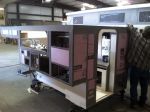 |
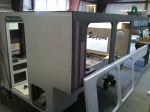 |
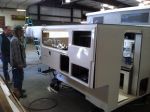 |
Above: The Coosa Hallmark features Hallmark’s molded fiberglass siding
TCM: If Coosa is a stronger material than wood, would it be possible to use less framing to save more weight without losing structural integrity?
Matt: After decades of refinement, Hallmark frames are already as minimal and efficient as possible without sacrificing structural integrity. We rely mostly on our composite outer shells for strength anyway. All of the inner frame structure we have is necessary for structural strength to attach components like bunks or jacks.
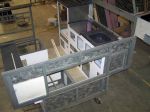 |
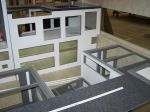 |
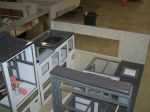 |
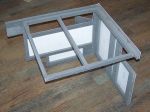 |
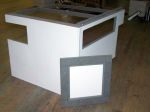 |
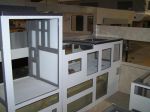 |
Above: The 100% Coosa modules, empty cabinets waiting for cabinet doors, and drawers
TCM: Can you work with Coosa the same way you work with wood?
Matt: Yes. Everything we can do with wood, we can do with Coosa. We can cut, screw, rout, staple, and use urethane adhesives with Coosa.
The yachting industry uses Coosa in their floors and bulkheads. The aerospace industry also uses Coosa in bulk heads. The Coosa we’re using even has an insulation value of R 3.8, very similar to the wood it replaces. It’s really a neat product.
TCM: What challenges did you encounter and overcome while developing the prototype Coosa models?
Matt: As a foam and fiberglass composite, we have to be careful when cutting Coosa as it does create airborne particles. When we work with raw Coosa, we put on gloves and a mask. You don’t want to touch raw Coosa with your hands until after it’s sealed.
TCM: How do you seal Coosa?
Matt: We seal with a urethane. Coosa seals just like wood does. Once the urethane sets Coosa becomes like rock. And if you ever had to repair it, you could cut it just like it was wood.
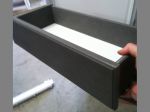 |
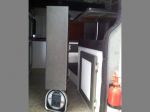 |
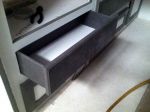 |
Above: The Coosa drawer weighed in at three pounds
TCM: You mentioned earlier that the Coosa Milner you built has zero wood. Do all Coosa Hallmarks have zero wood or aluminum?
Matt: Coosa campers can have zero wood or aluminum, if you choose. We can use Coosa to build the frame, floor, walls, cabinets, and drawers resulting in a camper with no wood or aluminum.
On the other hand, we recently competed a Cuchara that featured a Coosa floor and walls, but the customer wanted the interior cabinetry to be Cherry wood.
TCM: You can combine Coosa with wood and/or aluminum?
Matt: Yes. The ability of Coosa to be combined with wood or aluminum is a very important advantage of Coosa. For the Coosa Cuchara we built, the important structural elements of the camper were Coosa, but the interior was a beautiful natural wood. We believe most customers who opt for Coosa will order campers with this Coosa-wood hybrid approach.
TCM: You mentioned earlier that Hallmark still prefers wood framing. Now that you offer aluminum and Coosa framing, why does Hallmark prefer wood framing?
Matt: We are strong believers in the benefits of wood and have customers with decades old wood framed Hallmarks still going strong. TCM recently ran a story with Calendar Contest winner Jim McCoy. His Hallmark LaVeta is twenty-two years old. That’s not unusual. If you take care of it, a wood frame Hallmark will last for decades.
Coosa is an excellent option for anyone who either prefers to not use wood, or will be storing or using their camper in environments that are not appropriate for wood. For example, if you regularly use or store the camper near the ocean, or the often damp climate of the Northwest, it would be better to use Coosa for the floor and frame. Salt water in the air and constant dampness are not good for some wood products.
Some folks also need to avoid wood because of wood eating ants and other insects. For those customers, Coosa is highly recommended. For those customers who want an aluminum framed camper, aluminum is also available. Our goal is to offer the best options based on where our customers live in the world; wood, aluminum, or Coosa.
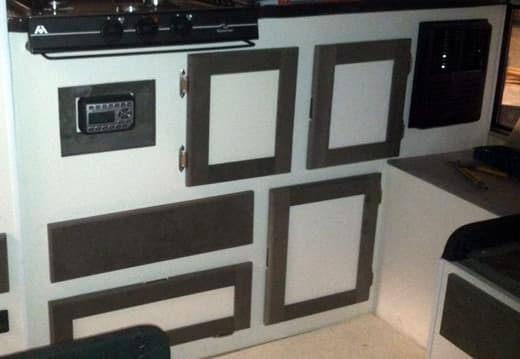
TCM: In the pictures of the 100% Coosa Milner, the color of the Coosa appears to be battleship grey. Can you get Coosa in different colors or finishes?
Matt: The 100% Coosa Milner is really a demonstration camper for Hallmark. With this demonstration camper, we wanted to prove to ourselves that Coosa is a viable material. We expect most customers will want a hybrid camper with a Coosa structure, and natural wood cabinets and drawers. We offer our customers the options, and they choose how they want their camper built.
TCM: Coosa comes in several types. What type of Coosa are you using?
Matt: We use Bluewater 26, Coosa’s strongest product. We order Coosa directly from the manufacturer in Alabama. We’re very excited that it’s made in the USA, just like Hallmark. Depending on the build, we use different size panels from half inch all the way up to one and a half inches.
TCM: Are you considering using other types of Coosa or other composites in the future?
Matt: For now, our big focus is using Coosa for the floors, sidewalls, drawers, and cabinets. For the 100% Coosa camper, we even used Coosa for the roof structure. Anywhere there is wood or aluminum in a camper, Coosa can be used.
TCM: Is Coosa available for any Hallmark camper? For example, can I order a K2 Coosa, or a LaVeta Coosa?
Matt: Yes. Every Hallmark model is now available as a Coosa model.
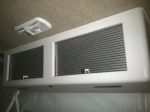 |
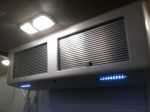 |
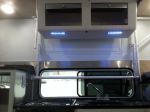 |
Above: The overhead cabinets feature LED lighting
TCM: What is the cost difference?
Matt: Coosa is an expensive product, especially compared to any wood it replaces. Coosa also takes us more time to work with, which also adds to the cost. To put this in perspective, a 4x8x3/4 wood panel costs $22.50. The same size panel in Coosa costs $170.00. It’s a significant difference and the main reason why the Coosa models cost more.
A Coosa floor, frame, and walls adds $4,000 to any Hallmark model. That Coosa camper will have wood interior cabinetry and is what we expect most Coosa customers will order. We can do a Coosa camper with 100% Coosa like the Milner in the photographs. Any level of Coosa can be built on a case by base basis. For example, if you only want a Coosa floor, we can do that.
 |
 |
 |
 |
 |
 |
Above: A nearly finished (top) and a finished Coosa camper (bottom)
TCM: Is the Hallmark warranty different for Coosa since it’s designed to last significantly longer?
Matt: We have an eight year structural warranty on the Hallmark Coosa campers because we have that much confidence in the Coosa product. On our regular wood framed Hallmark campers we have a five year structural warranty.
The warranty for an aluminum framed camper is three years. There is also a price increase for the aluminum frame option.
TCM: That gives the Coosa Hallmarks the longest structural warranty in the truck camper industry. That’s fantastic! You recently told us that you’re using Mylar in your soft walls. Tell us why you’re using Mylar.
Matt: Mylar has been in the space program since the 1970s. Mylar is like an emergency blanket that traps your body heat in. In our soft walls, Mylar reflects the radiant heat in the camper, retaining the heat longer.
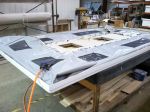 |
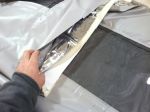 |
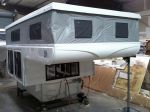 |
Above: Hallmark soft walls with the Mylar option installed
TCM: How are you using Mylar in the soft walls?
Matt: Mylar is actually very thin and lends itself to be sewn up in our soft wall. There were some challenges in laying it out. It is not super flexible, and you need it to be up and down just like a space blanket. As far as flexibility, when we cut it we overlap on the front and back sides, which allows for movement. We figured it out, and now it’s easier to work with.
We are still using Image Tech for the interior and exterior layers with closed cell foam in between. We’re just adding Mylar for more insulation. It works really well.
TCM: Are Mylar soft walls optional or standard?
Matt: Mylar is an option. Our standard insulated soft wall is good for most people. If you want something that’s more insulated, Mylar is an excellent upgrade.
TCM: What does the Mylar option cost?
Matt: It adds $500 to the camper. Retrofits to older campers are more costly but they can be done.
TCM: It’s clear that you’re busy with new materials and ideas at Hallmark. Is there anything else going on at Hallmark?
Matt: My brother, Andy is attending the Overland Expo in May. The 100% Coosa Milner will be there. Right now it’s being driven around on Andy’s truck.
TCM: Thanks Matt. TCM will have a reporter at the Overland Expo and we’ll be sure to have them check out the Coosa camper.
Matt: That would be great. Thank you.
